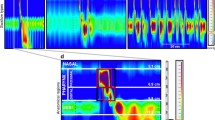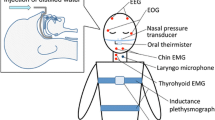Abstract
Sleep is associated with stages of relative cortical quiescence, enabling evaluation of swallowing under periods of reduced consciousness and, hence, absent volition. The aim of this study was to measure and characterize changes in the characteristics of pharyngeal swallows during sleep and wake using high-resolution manometry (HRM). Pharyngeal swallows were recorded with a ManoScan™ HRM in wake-upright, wake-supine, and sleep conditions in 20 healthy participants (mean 27 years; range 21–52). Velopharyngeal and hypopharyngeal segments were analysed separately. Contractile integral, mean peak pressure, inverse velocity of superior-to-inferior pharyngeal pressure, and time to first maximum pressure were analysed with custom-designed software. The supine-wake condition was compared to both upright-wake and sleep conditions using linear mixed effects models. No significant differences were found between supine-wake and upright-wake conditions on any measures. The mean peak pharyngeal pressure was lower during sleep than during the supine-wake condition for both the velopharynx (− 60 mmHg, standard error [SE] = 11, p < 0.001) and hypopharynx (− 59 mmHg, SE = 9, p = 0.001), as was the pharyngeal inverse velocity (− 12 ms/cm, SE = 4, p = 0.012) for the hypopharyngeal segment and the pharyngeal contractile integral (− 32 mmHg s cm, SE = 6, p < 0.001). No significant differences were found in time to the first pharyngeal maximum pressure. This study used HRM to characterize and compare pharyngeal pressures during swallowing in both wake and sleep conditions. No differences were found between upright and supine awake conditions, a finding important to pharyngeal manometric measures made during supine positioning, such as in fMRI. Higher pressures and longer time-related measures of volitional pharyngeal swallowing when awake indicate that cortical input plays an important role in modulation of pharyngeal swallowing.


Similar content being viewed by others
References
Sato K, Nakashima T. Human adult deglutition during sleep. Ann Otol Rhinol Laryngol. 2006;115:334–9.
Sato K, Nakashima T. Sleep-related deglutition in children. Ann Otol Rhinol Laryngol. 2007;116:747–53.
Sato K, Umeno H, Chitose S-I, Nakashima T. Deglutition and respiratory patterns during sleep in younger adults. Acta Otolaryngol. 2011;131:190–6.
Uludag IF, Tiftikcioglu BI, Ertekin C. Spontaneous swallowing during all-night sleep in patients with Parkinson disease in comparison with healthy control subjects. Sleep. 2016;39:847–54.
Sato K, Chitose S, Umeno H. Deglutition and respiratory patterns during sleep in the aged. Acta Otolaryngol. 2016;136:1278–84.
Lear CS, Flanagan JB, Moorrees CF. The frequency of deglutition in man. Arch Oral Biol. 1965;10:83–100.
Pinto A, Yanai M, Nakagawa T, Sekizawa K, Sasaki H. Swallowing reflex in the night. Lancet (Lond, Engl). 1994;344:820–1.
Anderson CA, Dick TE, Orem J. Swallowing in sleep and wakefulness in adult cats. Sleep. 1995;18:325–9.
Knigge MA, Thibeault S, McCulloch TM. Implementation of high-resolution manometry in the clinical practice of speech language pathology. Dysphagia. 2014;29:2–16.
Lamvik K, Jones R, Sauer S, Erfmann K, Huckabee M-L. The capacity for volitional control of pharyngeal swallowing in healthy adults. Physiol Behav. 2015;152:257–63.
Lamvik K, Hernandez EG, Jones R, Huckabee M-L. Characterization and correction of pressure drift in the ManoScan(™) high-resolution manometry system: in vitro and in vivo. Neurogastroenterol Motil. 2016;28:732.
Robertson EV, Lee YY, Derakhshan MH, Wirz A, Whiting JRH, Seenan JP, Connolly P, Mccoll KEL. High-resolution esophageal manometry: addressing thermal drift of the manoscan system. Neurogastroenterol Motil. 2012;61:e11.
R: A language and environment for statistical computing. R Foundation for Statistical Computing. Vienna; 2017.
Bates D, Mächler M, Bolker BM, Walker SC. Fitting linear mixed-effects models using lme4. J Stat Softw. 2015;67:1–48.
Virkkula P, Silvola J, Maasilta P, Malmberg H, Salmi T. Esophageal pressure monitoring in detection of sleep-disordered breathing. Laryngoscope. 2002;112:1264–70.
Oeverland B, Akre H, Kvaerner KJ, Skatvedt O. Patient discomfort in polysomnography with esophageal pressure measurements. Eur Arch Otorhinolaryngol. 2005;262:241–5.
Hessel NS, Laman M, van Ammers VCPJ, van Duijn H, de Vries N. Feasibility study of Flextube reflectometry for localisation of upper airway obstruction in obstructive sleep apnea. Rhinology. 2003;41:87–90.
Dejaeger E, Pelemans W, Ponette E, Vantrappen G. Effect of body position on deglutition. Dig Dis Sci. 1994;39:762–5.
Barkmeier J, Bielamowicz S, Takeda N, Ludlow C. Laryngeal activity during upright versus supine swallowing. J Appl Physiol. 2002;93:740–5.
Acknowledgements
The authors wish to thank the Canterbury Medical Research Foundation for its financial support for this project.
Author information
Authors and Affiliations
Corresponding author
Ethics declarations
Conflicts of interest
The authors declare they have no conflict of interest.
Rights and permissions
About this article
Cite this article
Guiu Hernandez, E., Gozdzikowska, K., Jones, R.D. et al. Pharyngeal Swallowing During Wake and Sleep. Dysphagia 34, 916–921 (2019). https://doi.org/10.1007/s00455-019-09989-6
Received:
Accepted:
Published:
Issue Date:
DOI: https://doi.org/10.1007/s00455-019-09989-6




